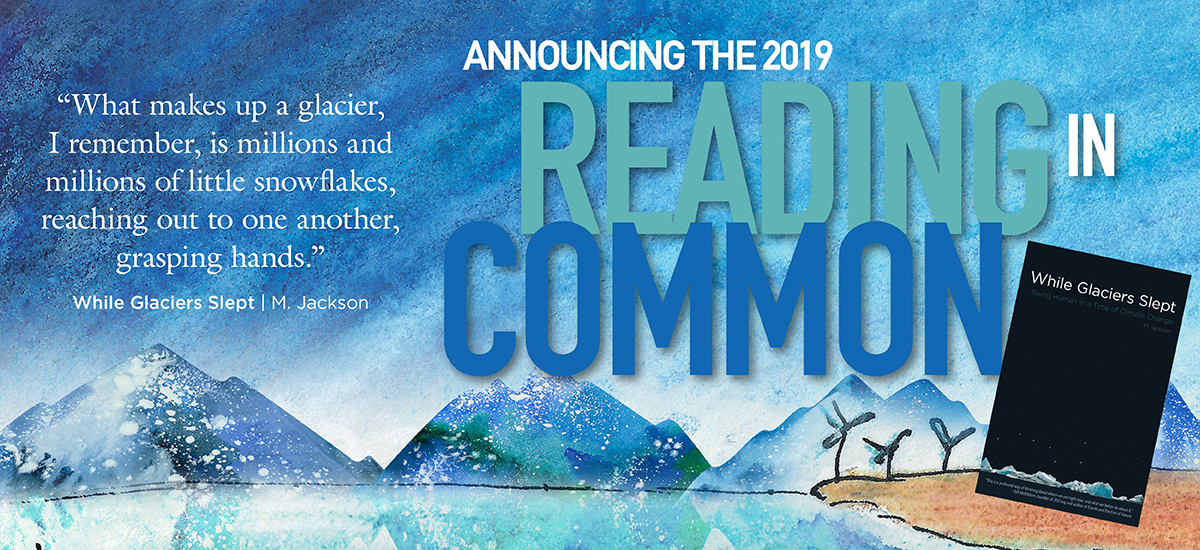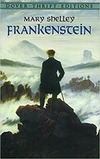Reading In Common Program2017: Frankenstein
About the Book
Mary Shelley was eighteen years old when she began writing Frankenstein, or The Modern Prometheus (1818), arguably the novel that began the genre of science fiction in the English language. Frankenstein tells the story of scientific ambition and what happens when intellectual discovery is pursued in isolation and without consideration of ethics. The novel is also a story about the bonds – emotional, psychological, and social – that tie humans to other sentient beings.
Victor Frankenstein is a brilliant student whose obsession is to create a new species of human life. Against the advice of his scientist-professors, he makes the Creature by sewing together dead body parts, giving him life through electricity. But once the Creature becomes conscious, Victor abandons him, leaving the young Creature to fend for himself. Victor panics when his close friends and family members mysteriously begin to die. The Creature returns, identifying himself as the cause of Victor’s torment. High in the Swiss Alps, the creator and Creature confront each other. The Creature reveals his despair over his isolation and the ostracism he faces. He pleads with Victor to create a female mate. Victor’s subsequent actions unleash the Creature’s fury. Victor and the Creature track each other from Scotland to Switzerland, from Russia into the far reaches of the Arctic, where they meet their end in a thrilling conclusion. (SP)
About the Author: Mary Shelley
Mary Shelley (1799-1851) was a novelist, essayist, and editor who is best known to modern readers as the author of Frankenstein, which has been in print since its publication in January 1818. Mary Shelley was the daughter of the radical political philosopher William Godwin and the feminist philosopher and novelist Mary Wollstonecraft, who died from complications of childbirth. Educated mostly by Godwin, Mary Shelley read widely in the classics and modern languages. Among Godwin’s many admirers was the Romantic poet Percy Bysshe Shelley, himself the controversial author of political poetry. In 1814, Mary and Percy Shelley eloped to Europe and were legally married two years later. As recalled by Mary Shelley, on a stormy night in 1816 near Geneva, Switzerland, she took part in a ghost-story writing contest with Lord Byron (poet and political activist), his doctor, William Polidori, and Percy Shelley. This was the genesis of Frankenstein, now considered one of the most important and popular novels written in the 1800s.
Mary Shelley continued to write novels after Frankenstein, including Valperga, The Last Man, and Falkner. After the death of Percy Shelley, she edited his complete poetical works, and continued to publish literary journalism in the leading magazines of her time. She died, aged 53, survived by a son, the only living child of the four children from her marriage with Percy Shelley. In the 1970s, feminist literary criticism brought renewed attention to Mary Shelley, especially her remarkable novel Frankenstein. The novel and its characters continue to live on in our cultural imagination in sci-fi and horror films, in neologisms such as “frankenfood,” in speculative fiction about artificial intelligence, and in recent debates about reproductive technologies, this year’s Nobel Conference theme. (SP)
Reading in Common Events:
Frankenstein Film Fest, Tuesday, September 12, 2017, at 7 p.m. in Wallenberg Auditorium
Frankenstein Live Marathon Reading, Thursday, September 28, 2017, beginning at 10 a.m. in the Courtyard Cafe.
Join students, faculty, staff, and community members as we stage a live, marathon reading of Frankenstein. This event will begin at 10 a.m. at the Courtyard Cafe in the Jackson Campus Center and will continue until we finish the book. Costumes and props are strongly encouraged and everyone is welcome to participate as a reader or audience member.
Frankenstein Film Fest, Friday, October 13, 2017, at 7 p.m. in the Wallenberg Auditorium.
53rd Nobel Conference, Reproductive Technology: How Far Do We Go?, Tuesday, October 3, 2017, and Wednesday, October 4, 2017, in the Lund Arena.
For supplemental readings related to Frankenstein, please explore the following websites. These additional readings can help frame the text for dialogue and discussion from a variety of disciplinary perspectives. The Folke Bernadotte Library also has a display of books related to Frankenstein and the Nobel Conference on the main level of the library.
- https://www.insidescience.org/news/science-made-frankenstein
- http://www.slate.com/articles/technology/future_tense/2017/01/what_artificial_intelligence_researchers_can_learn_from_frankenstein.html
- https://newrepublic.com/article/134271/frankensteins-monster-became-human
- https://www.theatlantic.com/science/archive/2017/04/franken-science/523560/
- http://www.smithsonianmag.com/arts-culture/geography-of-frankenstein-180956964/
- http://people.brandeis.edu/~teuber/shelleybio.html
- http://members.aon.at/frankenstein/comic/marvel_comics.htm
- http://knarf.english.upenn.edu/Articles/sterren.html
- http://www.npr.org/sections/codeswitch/2017/06/22/533512719/updating-frankenstein-for-the-age-of-black-lives-matter
What do first-year students need to do?
- Actively read this book before arriving on campus.
- Take notes.
- Highlight passages you think are important.
- Consider the following questions for discussion:
- Is the creature human? What does Frankenstein tell us about what it means to be human?
- How is education portrayed? In what ways does Frankenstein challenge conventional ideas about the value of education and the pursuit of knowledge?
- What do you notice about how the creature is treated by his creator (Victor) and by the people he encounters? Do we see a similar treatment of some people or groups of people in today’s society?
- How does the story connect to contemporary concerns about the consequences of significant developments in reproductive technology such as cloning or in vitro fertilization?
- Be prepared to discuss the book with your Gustie Greeter and group facilitator during orientation.
Obtaining Your Copy
- Students who attend Gustie Gear Up will receive a complimentary copy of the book. The Book Mark, located on the lower level of the Jackson Campus Center, has many copies of the book available with a special Reading in Common insert. If you miss the opportunity at registration, you may also purchase the book online at The Gustavus BookMark.
- We will be using the Dover Thrift Edition of the book.
Goals and Aims of the Program
- Encourage intellectual interaction among students in conjunction with faculty
- Welcome students to the academic life of Gustavus
- Facilitate a shared academic experience for all students
- Emphasize reading as a significant component of the college experience
- Tie together transition and integration experiences of first-year students
- Provide opportunities for first-year students to explore issues and ideas relevant to our community and our world
- Connect to the Nobel Conference theme
How is the Reading In Common Program used?
All first-year students and Gustie Greeters read the book over the summer. These students will meet with faculty members during orientation to discuss the book. The book is often used as a reference or resource in students' First Term Seminars (FTS).
History of the Program
The Reading In Common Program began in the 2000–2001 Academic Year. Books in the Reading In Common Program have included:
- 2017: Frankenstein by Mary Shelley
- 2016: Between the World and Me by Ta-Nehisi Coates
- 2015: The Immortal Life of Henrietta Lacks by Rebecca Skloot
- 2014: Where Am I Wearing?, Where Am I Eating? by Kelsey Timmerman
- 2013: A Pearl in the Storm by Tori Murden McClure
- 2012: The Other Wes Moore by Wes Moore
- 2011: The Wolf at Twilight by Kent Nerburn
- 2010: Hotel on the Corner of Bitter and Sweet by Jamie Ford
- 2009: Enrique's Journey by Sonia Nazario
- 2008: Chinese Lessons: Five Classmates and the Story of the New China by John Pomfret
- 2007: Mountains Beyond Mountains by Tracy Kidder
- 2006: Honky by Dalton Conley
- 2005: The Kite Runner by Khaled Hosseini
- 2004: When the Emperor Was Divine by Julie Otsuka
- 2003: The Things They Carried by Tim O'Brien
- 2002: The Legacy of Luna by Julia Butterfly Hill
- 2001: The Chosen by Chaim Potok
- 2000: The Samurai's Garden by Gail Tsukiyama
Books are chosen based on their literary quality, reading manageability (college level reading but not too long), interdisciplinary nature, and connection to the Nobel Conference theme.

